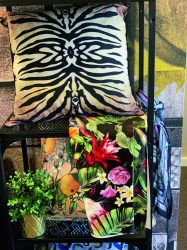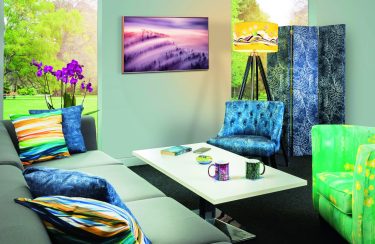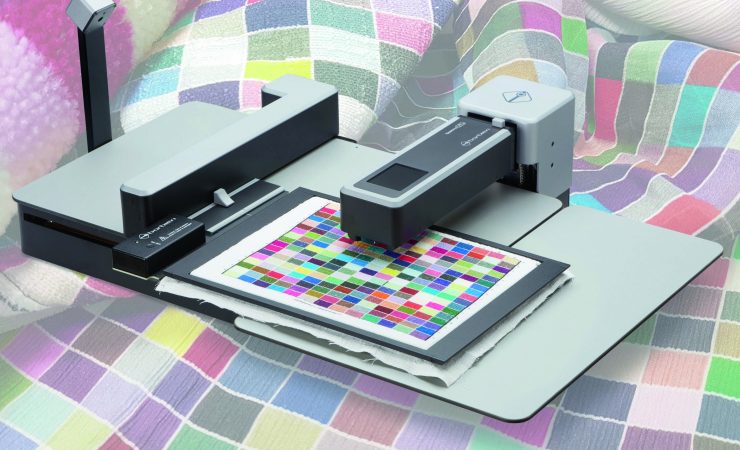With the proliferation of digital textile printers for applications from soft signage to fast fashion, getting colours correct and consistent is as much an issue as it is for any other type of print. Simon Eccles digs out his spectrophotometer
Achieving accurate colour for textile printing is just as important as for wideformat signage print, except the diversity of materials can be even more challenging. Depending on your printer and ink combination, you’ll be faced with a choice of natural or synthetic materials for soft signage, interior furnishing and garments.
‘Understandably, a corporate colour produced on a calico cloth will be a challenge to match to the same brand’s palette produced on an optically brightened piece of sportswear fabric because of the limitations of the former,’ says Brett Newman, chief operations manager at Hybrid Services, Mimaki’s exclusive distributor for the UK and Ireland.
‘However, there will usually be a call to be made by the designer or specifier as to what is acceptable. A fabric print has many facets that add value, such as the handle, the way light affects the look of the print such as a velvet or sateen, or its transparency, and all will alter the way a colour is represented. Even something as simple as a forecourt feather flag with a printed logo will be very subjective as to its colour, as this will markedly differ when viewed with a dark object behind it when compared to viewing against a bright sky.’
Stefan Barbieri, CEO of Italian measurement instruments company Barbieri Electronic, elaborates: ‘Materials and absorption are all different and even between the same material there can be differences from one batch to the next. The stability of the process is more complex on dye sublimation printing because of the transfer process, but there are other influences on other dye processes, such as washing.’
Paul Rasterick, pre-sales technical manager at Epson UK, points out that, ‘The mechanical parameters are often an overlooked area when it comes to inkjet printing, but if the media feeds too much or the head height is not correctly set, this will have an impact on dot position which ultimately effects the colour reproduction.’
Profiling (almost always using ICC profiles) for the effect of inks on media is the main answer to consistency and matching between processes and for repeat consistency. ‘Colour profiling is important because of the range of fabrics,’ says Brett Platt, textile business manager for CMYUK. ‘So are the printer settings – fixing temperatures can be as important as inks.’
His company supplies wide-format textile printers: the EFI Vutek FabriVu series for direct dye sublimation, plus lower cost Mimakis mainly to customers who want to print via transfer sublimation onto paper. The company also supplies a lot of the printable textiles.
‘We don’t just install the machine, give the customers some profiles and say ‘there you go’,’ says Mr Platt. ‘Typically these are wide-format display printers moving into soft signage for the first time. A lot of customers have had 3m and 5m UV printers for years and understand profiling for them, but it’s different for textiles. Skin tones, spot colours, Pantone matching, all need to look correct. We spend several days with customers in setting up and creating presets for backlits, frontlits and difficult materials.’
Chris Schowalter is director of Fiery market segment management at EFI Europe. EFI’s Fiery XF RIP is available with drivers to drive many makes of large format printers, including textile models, as well as EFI’s own Reggiani and FabriVu textile printers. ‘We do a lot of research and as a result we have to adjust hardware or software,’ he says. ‘For instance linearisation, where for shadow areas you need a decent amount of ink, but it can become pretty muddy quite quickly. We now offer Fiery Intensify, a new technology for [the] saturation rendering intent when using Fiery Edge ICC profiles. Not many people used saturation controls before as it didn’t work too well.’
Mimaki’s textile printers are supplied as standard with the company’s TxLink3 Lite RIP software which incorporates a number of textile-specific features. ‘For printers seeking further functionality, an optional and even more comprehensive RIP package, TxLink4, is also available,’ says Mr Newman. ‘This has 16-bit rendering, the ability to print variable data, for example teamwear sports numbers and names, and even layered colour combining’; the latter overlays colours to create new ones, rather like screen printing.
Mr Newman adds that, ‘The dye sublimation profiling process incorporates variables such as the absorbency of the fabric which will affect the dot gain, its white point, the heat and dwell time during fixation, ink limits and subsequent yield of the paper – it’s very much just a matter of tying them down to ensure consistent results.’

The colours need to be not just bright, but right. Samples of sublimation and pigment printed products from CMYUK
Transfer function
Epson sells a pair of wide-format dye sublimation printers for paper transfers plus one that prints pigment ink directly onto natural fibres, with a platen to take T-shirts and the lie. Epson’s Edge Rip software (which can also be incorporated in third party printers that use Epson heads) takes print-data files called EMX – Epson Media Xtension. Paul Restarick says: ‘Each EMX file contains the relevant LUT [look-up table] information for the media, ICC profile for colour reproduction and the mechanical parameters used to set the printer for tensions, head height, heaters, etc. EMX files are delivered from our cloud-based server to the customer via our Epson Edge Dashboard solution.’
He says the EMX cloud server hosts over 200 media types, both Epson’s own brand and third-party suppliers such as Coldenhove, Beaver, Felix Schoeller, Cham and Hansol.
HP entered the dye sublimation sector for the first time a couple of years ago with its Stitch models. These are supplied with the ErgoSoft RIP (as also used by Roland DG’s Texart textile printers) and HP has created a range of ICC profiles which are in a cloud site for users to download as needed. The Stitch printers use HP’s SmartColor technology that can pick up Pantone values in the artwork and make a ‘best visual match’ if needed, and includes a built-in spectrophotometer that can maintain colour consistency on the run and help to match other Stitch printers.

Examples from Epson of what can be printed using dye sublimation of fabrics
Spot on
If you often need to print on new materials it could be worth investing in your own profile making kit, though printer suppliers and third-party specialists will offer profile making as a service.
X-Rite dominates the market for measurement instruments and profiling software, having bought out most of its competitors in the early 2000s. For more than a decade X-Rite’s entry level i1 family of affordable, stylishly designed hand-held spectrophotometers and modular accessories have been all that most printers, photographers and designers would need for profile-making and on-the-run quality checking. The standard manual versions aren’t fast, but there are automation options, while refinements in patch sets over the years makes even manual use a lot quicker.
The start of this year saw the release of the latest version of the core i1Pro 3 spectrophotometer in several bundled packages aimed at different markets. Most relevant to textiles printers is i1Publish Pro 3 Plus, which is intended for creating CMYK+ profiles with up to four extra ink colours. This includes textile-friendly features including a measurement table with lockable magnetic bars for textile samples, a larger 8mm aperture and polarising filters to help the reading of textiles and other textured media.
‘The i1Pro3 Plus supports transmissive measurements and that was one of the main reasons for the model upgrade, says Richard Gray, solution architect at X-Rite UK. ‘Typical markets are backlit signage and wrap-round printed laminates for vehicles.’
UK specialist Color Confidence currently lists the i1Publish Pro 3 Plus at £2736, which is £500 more than the nonPlus version, but it’s offering a £500 trade-in against earlier i1 Pros.
Barbieri Electronic is a much smaller company than X-Rite but it has made its mark in the past decade or so by making spectrophotometers designed to read wide-format media including thick panels and lately, textiles. At Fespa 2019 it introduced the Textile Edition Spectro LFP qb. Stefan Barbieri says that customers so far have included ‘big industrial customers, mostly apparel production such as MS, Reggiani/EFI, Durst, and customers with multiple smaller dye sublimation printers.’
At around £10,400 it costs considerably more than the X-Rite i1 Publish Pro 3 Plus, but the Barbieri is motorised and automated as standard, which makes patch reading a lot less tedious. A motorised table kit for the i1 Pro costs an extra £2700, which is still half that of the Barbieri.
It took a while for the large format graphics sector to catch on to the need to control colour variables. The textile market overlaps with this but is in other ways different. How is it progressing? ‘It depends on the market,’ says Mr Schowalter at EFI. ‘Soft signage guys have mid-level awareness. It’s generally less than for packaging, but they’re needing it more and more. In the garment space, they still think in terms of (analogue) RGB and inks that are mixed in a bucket and go back and forth to be checked until they’re right. Now brands are insisting on high digital colour tolerances, which is absolutely possible, but the customers don’t have the knowledge yet.’
EFI has developed training for this, he says. ‘We have professional services offerings for on-site training. We also have one of the most intense online universities of any RIP manufacturers. We have two four-day courses, leading to either Professional or Expert certificates; actually the courses are free if you don’t need the certificates.’
Things are changing quickly in digital textile printing and many printers are seeing it as a useful adjunct to other types of production, typically moving first into soft signage. Being able to offer accurate and consistent colour across printers, fabrics and jobs must surely be one way of standing out from the crowd.





